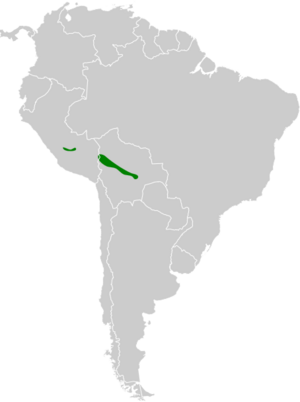Yungas antwren facts for kids
Quick facts for kids Yungas antwren |
|
|---|---|
| Conservation status | |
| Scientific classification | |
| Genus: |
Myrmotherula
|
| Species: |
grisea
|
 |
|
The Yungas antwren (also known as the ashy antwren) is a small bird. Its scientific name is Myrmotherula grisea. It is part of the "typical antbirds" family, called Thamnophilidae. You can find this bird living in the countries of Bolivia and Peru.
Contents
About the Yungas Antwren
Bird Family and Grouping
The Yungas antwren is a unique species, meaning it does not have different subspecies. It seems to be closely related to a few other antwrens. These include the unicolored antwren, the Alagoas antwren, and the plain-winged antwren. They are thought to be a special group because they sound similar and live in similar places.
What the Yungas Antwren Looks Like
The Yungas antwren is a small bird, about 8.5 to 9.5 cm (3.3 to 3.7 in) long. It weighs around 8 to 10 grams (0.28 to 0.35 oz). It has a short tail.
Male and Female Birds
Adult male Yungas antwrens are mostly gray. Their wings and tail are a bit darker and more brownish-gray than their body.
Adult female Yungas antwrens have a brownish-yellow face. Their upper body is mostly olive-brown. Their head and upper back have a grayish tint. Their tail is dark brown with reddish-brown edges on the feathers. Their chin and throat are brownish-yellow. Their belly is yellowish-orange, becoming browner on their sides. Young males look like adults but might have some yellowish-brown patches.
Where the Yungas Antwren Lives
For a long time, people thought the Yungas antwren only lived in western Bolivia. It was found on the eastern side of the Andes mountains in areas like La Paz, Cochabamba, and Santa Cruz. Some bird lists still only show it in Bolivia.
However, since the early 2000s, this bird has also been seen in southeastern Peru. It lives in the Cuzco and Puno regions there.
Preferred Home and Environment
In both Bolivia and Peru, the Yungas antwren lives in evergreen forests. It prefers the middle and upper parts of the trees in foothills and mountain areas. It can also be found in the lower parts of the forest, especially near the edges. These birds usually live at elevations from 500 to 1650 meters (1,600 to 5,400 ft) above sea level. Most often, they are found between 700 and 1200 meters (2,300 and 3,900 ft).
Yungas Antwren Behavior
Movement and Travel
The Yungas antwren is believed to stay in the same area all year round. It does not migrate to different places.
How the Yungas Antwren Finds Food
We don't know all the details about what the Yungas antwren eats. However, it probably eats mostly insects and spiders. It searches for food alone, in pairs, or with its family. Often, it joins groups of different bird species that are feeding together.
It usually looks for food between 1 and 20 meters (3 and 66 ft) above the ground. It actively searches for prey, especially in bunches of dead leaves. It also finds food on live leaves and moss.
Reproduction and Life Cycle
Sadly, we do not know anything about how the Yungas antwren breeds or raises its young.
Vocalization and Sounds
The Yungas antwren's song is a quick series of simple notes. These notes are slightly slurred downwards and stay at about the same pitch.
Its calls include a sharp, upward-slurred "wheep." It also makes an upward-slurred double note that sounds like "do-leep."
Conservation Status
The IUCN (International Union for Conservation of Nature) has changed its assessment of the Yungas antwren's status over the years. In 1988, it was considered Threatened. Then in 1994, it was Vulnerable. In 2008, it became Near Threatened. But since 2012, it has been listed as of Least Concern. This means it is not currently in immediate danger of disappearing.
Threats to the Yungas Antwren
The known area where this bird lives has grown since the year 2000. We don't know the exact number of Yungas antwrens, and their population is thought to be slowly decreasing.
The main threat to this bird is deforestation. This means forests are being cut down within its small living area, especially in the La Paz and Cochabamba regions. Even so, there are still large areas of untouched forest in hard-to-reach places where the bird lives. The foothill forests where this species lives are drier than forests higher up. This makes them easier to clear for new settlements. The Yungas antwren is considered uncommon to common, but it lives in only one major protected area.


